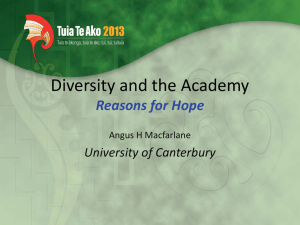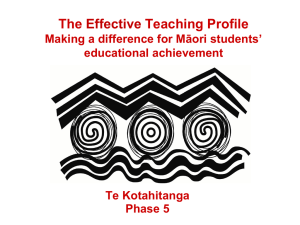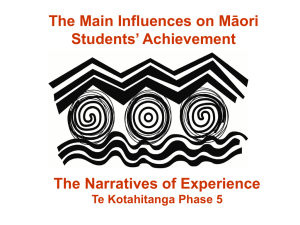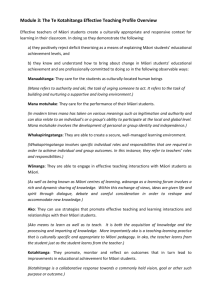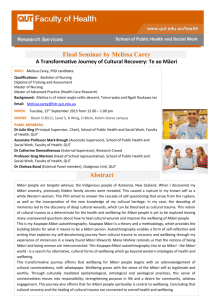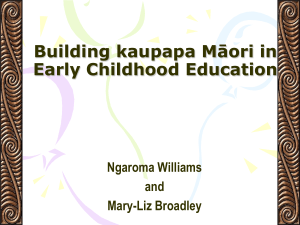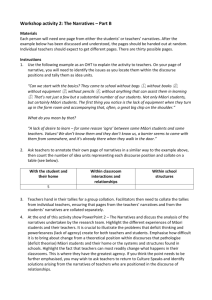Brief Background on New Zealand
advertisement
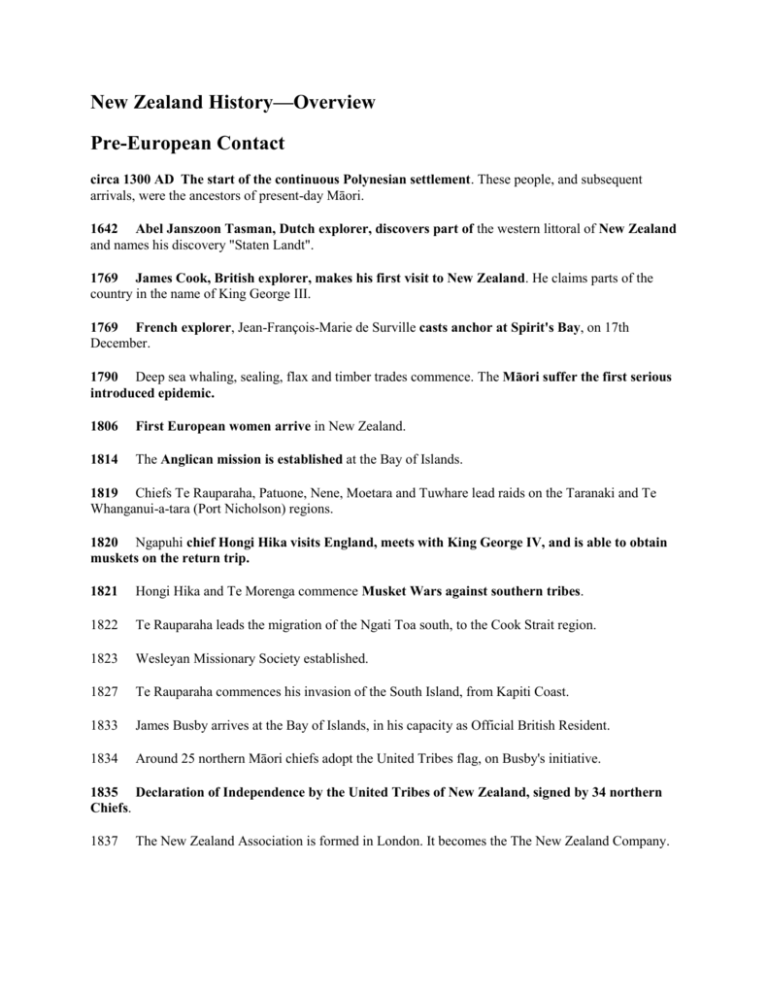
New Zealand History—Overview Pre-European Contact circa 1300 AD The start of the continuous Polynesian settlement. These people, and subsequent arrivals, were the ancestors of present-day Māori. 1642 Abel Janszoon Tasman, Dutch explorer, discovers part of the western littoral of New Zealand and names his discovery "Staten Landt". 1769 James Cook, British explorer, makes his first visit to New Zealand. He claims parts of the country in the name of King George III. 1769 French explorer, Jean-François-Marie de Surville casts anchor at Spirit's Bay, on 17th December. 1790 Deep sea whaling, sealing, flax and timber trades commence. The Māori suffer the first serious introduced epidemic. 1806 First European women arrive in New Zealand. 1814 The Anglican mission is established at the Bay of Islands. 1819 Chiefs Te Rauparaha, Patuone, Nene, Moetara and Tuwhare lead raids on the Taranaki and Te Whanganui-a-tara (Port Nicholson) regions. 1820 Ngapuhi chief Hongi Hika visits England, meets with King George IV, and is able to obtain muskets on the return trip. 1821 Hongi Hika and Te Morenga commence Musket Wars against southern tribes. 1822 Te Rauparaha leads the migration of the Ngati Toa south, to the Cook Strait region. 1823 Wesleyan Missionary Society established. 1827 Te Rauparaha commences his invasion of the South Island, from Kapiti Coast. 1833 James Busby arrives at the Bay of Islands, in his capacity as Official British Resident. 1834 Around 25 northern Māori chiefs adopt the United Tribes flag, on Busby's initiative. 1835 Declaration of Independence by the United Tribes of New Zealand, signed by 34 northern Chiefs. 1837 The New Zealand Association is formed in London. It becomes the The New Zealand Company. 1839 William Hobson is instructed to establish British rule in New Zealand, which initially becomes a dependency of New South Wales. Colonel William Wakefield arrives on board the "Tory" with instructions from his brother Edward to buy as much land as possible for future colonists. 1840 The first New Zealand Company settlers arrive at Port Nicholson. The Treaty of Waitangi is signed at the Bay of Islands, on 6th February. (external government link here : Treaty of Waitangi ) French settlers arrive at Akaroa just after the signing of the Treaty.William Hobson becomes the first Governor. 1841 European settlers are established at New Plymouth and Wanganui.Auckland becomes the capital from the Bay of Islands. 1842 Settlers arrive at Nelson. 1843 The "Wairau Affair". Violent confrontation between Europeans and the Māori. Robert Fitzroy becomes Governor. 1845 Hone Heke and Te Kawiti commence the northern wars. 1846 The wars in the north end with the taking of Ruapekapeka. 1858 Te Wherwhero installed as first Māori King, with the name of Potatau I. 1859 Gold discovered in Buller. 1860 War in Taranaki, resulting from the Waitara dispute. 1861 Gold discovered at Gabriel's Gully - the Otago gold rushes commence. 1863 War recommences in Taranaki.The New Zealand Settlements Act is passed to push through land confiscation. First steam railway in New Zealand commences. 1864 The Waikato war ends. Land in Waikato, Taranaki, Bay of Plenty and Hawke's Bay is confiscated. 1865 Auckland streets lit by gas for the first time. Māori resistance continues. 1868 Māori resistance continues under the leadership of Te Kooti Arikirangi and Titokowaru. 1870 The last of the British Imperial Forces leave New Zealand. Vogel's public works and immigration policy commences. Over 1.000 miles of railway are constructed. 1872 Te Kooti retreats into the King Country. Māori armed resistance ceases. 1881 Parihaka community forcibly broken up by troops. Te Whiti, Tohu Kakahi and their followers are arrested and imprisoned. (1883 Te Kooti officially pardoned.) 1884 King Tawhiao visits England with a petition for the Queen, appealing to the Treaty. He is refused access. 1886 The eruption of Mount Tarawera. Oil discovered in Taranaki. 1893 Women granted the right to vote. 1897 Apirana Ngata and other Young Māori intellectuals form the Te Aute College Students Association. Timeline (shortened) from http://history-nz.org/timeline.html Overview of Māori and Pākehā relations in the twentieth century Until 1940, when it stated the New Zealand population the Official Yearbook always noted the figure was ‘exclusive of Maori’ – as if from some statistical viewpoint there were two separate nations. Maybe it was a hangover from an earlier time when Māori were seen as a race on the verge of extinction; adding them to the population seemed unnecessary. The 1896 census counted fewer than 40,000 Māori, perhaps a quarter of the number who lived here a century earlier. By 1911 there were clear signs of recovery, with 50,000 Māori recorded. But in a total population of just over one million, Māori influence upon the nation's affairs was almost non-existent. Some of the credit for this recovery in the first decade of the 20th century lay with Māui Pōmare (the first Māori medical graduate), who was appointed the Department of Health's Maori Medical Officer in 1901. He was joined in 1905 by Te Rangi Hīroa (Peter Buck). Campaigns to improve Māori sanitation and health, as well as vaccination programmes, had helped reduce the impact of disease. But Māori housing and health standards remained inferior to those of Pākehā. Infant mortality was high and at birth Māori life expectancy was in the mid-20s – less than half that for non-Māori. Fast-forward seven decades to 1980 and the Māori population approached 300,000. This recovery had perhaps the single greatest effect on race relations during this period. Increasingly, government policies had to consider Māori needs. Māori also had to find their place in a wider New Zealand society that overwhelmingly reflected the values, needs and practices of the majority Pākehā culture. This encouraged the development and emergence of new leaders and responses. The Treaty of Waitangi, an historical relic for many New Zealanders, now became the basis of debate over New Zealand’s past as well as its future. Maori and Pakeha relations 1900-1945 Māori entered the 20th century economically disadvantaged by a range of government policies and actions which had severely reduced their landholdings. During the second half of the 19th century land held by Maori under communal title had been halved from 8.8 million hectares to 4.4 million. Over the next 30 years this total was halved again as successive governments vigorously encouraged the development of farming. The opening decades of the 20th century saw a number of new Māori leaders emerge. The aforementioned Pōmare and Buck were joined by fellow Te Aute College graduate Āpirana Ngata to form the nucleus of what was known as the Young Maori Party. This group played a leading role in providing direction for Māori as far as government policies and initiatives were concerned. They tended to work within the mainstream of New Zealand politics and urged Māori to make the most of the ‘Pākehā way’. They believed it was important to retain those aspects of Māori society that were compatible with ‘modern life’ and essential to the survival of their culture. Ngata led a renaissance in Māori knowledge and culture, as did the important Waikato leader Te Puea Hērangi [a woman!]. [….] World War I—to fight for the British or not? Māori had mixed views about the First World War. Those iwi who supported the war effort were from tribes noted for their loyalty to the Crown. The four Māori MPs were united in their support for Māori participation in the war. Peter Buck led from the front and volunteered for service. He believed fighting together as a group might break down what he saw as the negative aspects of tribalism and help unify Māori. Ngata believed involvement would strengthen Māori claims for equal status with Pākehā. Those Māori who did not answer the call to fight for 'King and Country' were largely from Taranaki and Tainui–Waikato. In these areas there was still bitterness about the confiscation of land following the wars of the 1860s. King Tāwhiao, having made his peace with the Crown in 1881, forbade Waikato to take up arms again. His grand-daughter Te Puea intended to honour this. When conscription was imposed on Waikato Māori from 1917 she supported those men who refused to report for service. By the end of the war, 2227 Maori served in what became known as the Maori Pioneer Battalion. Of these, 336 died on active service and 734 were wounded. Māori enlisted (and died) in other units as well. During the war violence broke out at Maungapōhatu when armed police were sent to arrest the Tūhoe prophet Rua Kēnana. Kēnana had apparently stated that the German Kaiser would appoint him King of New Zealand once Germany had defeated the Allies. Flu Pandemic 1918 The influenza pandemic that struck New Zealand between October and December 1918 killed 8600 New Zealanders, almost half as many as had been killed in the whole of the First World War. No event has killed so many New Zealanders in such a short time. The impact on many Māori communities was particularly severe. Two thousand Māori died and their percapita death rate was seven times that of Pākehā. The impact of the pandemic would be felt for many years to come. Te Puea took responsibility for more than 100 children orphaned in the Waikato.[. . . .] Māori arts and crafts Te Puea and Ngata worked hard to maintain traditional Māori arts and crafts. In 1927 a carving school was established in Rotorua under the Maori Arts and Crafts Act 1926, championed by Ngata. Te Puea was also instrumental in establishing a carving school at Ngāruawāhia, led by master carver Piri Poutapu. Land In 1928 Ngata became Native Minister in the United Party government. In 1929 legislation provided for government loans to assist Māori land development. Of particular concern was the fragmentation of Māori land which meant it was often divided into many small, unproductive plots. Ngata believed the solution was to consolidate this land by joining it together into larger, more economical farms. He extended the scheme from his own East Coast area to Waikato, where he worked closely with Te Puea. Numerous development schemes were begun in the early 1930s, although not all were successful. Allegations of financial irregularities in these schemes saw Ngata resign as minister in 1934. In contrast to the First World War there was no organised Māori opposition when war was declared on Germany in September 1939. Te Puea retained concerns about fighting for the British Crown while the matter of confiscation had not been addressed. But she did not stand in the way of men from the region enlisting. She raised money for the Red Cross and organised material support for the men of the 28th (Māori) Battalion, By the time the war ended in 1945 the Battalion had become one of the most celebrated and decorated units in the New Zealand forces. Nearly 16,000 Māori enlisted for service, which Ngata saw as the ‘price of citizenship’. The tribally based Maori War Effort Organisation also assisted with recruitment and war-related services, adding to a sense that Māori had indeed played their part as citizens. After the war Māori servicemen received full rehabilitation assistance from the government. The Second World War and Māori urbanisation On the eve of the Second World War only 10% of Māori lived in urban areas, compared with almost 60% of Pākehā. The war changed this. The Manpower Act directed young Māori men (who were ineligible for the military) and women to work in essential industries, often located in cities. By 1951 the number of Māori living in urban areas had doubled. Within a generation of the war ending, 68% of Māori lived in urban areas. As a consequence Māori and Pākehā were interacting on a more regular basis. Native to Māori In 1947 Peter Fraser’s Labour government officially replaced the generic word ‘native’ with Māori. This change was more than symbolic. It clearly acknowledged the unique place and identity of Māori in New Zealand. Māori migrants to the city faced many difficulties, not least the separation from whānau and traditional structures of support. There were fears that younger Māori would ‘lose their way’ in the city. Some Māori attempted to bring traditional institutions into the cities by establishing urban marae. With Māori from a variety of areas moving into town, tribal distinctions became blurred. Māori also faced problems acquiring suitable housing. Some Pākehā landlords were reluctant to rent properties to Māori tenants. They feared that properties would become overcrowded through chain-migration – this was a familiar process where whānau moved to properties established by the first wave of family migrants. Older inner-city housing was often all Māori could afford at a time when suburban development was seeing more people move to the suburbs (this trend would later be reversed as the middle-classes moved back to the inner city to restore these older houses to their former glory). Leadership concerns The Second World War stripped both the Pākehā and Māori communities of many potential leaders. Making matters worse for Māori was the death of Ngata in 1950 and Te Puea in 1952. There were few obvious replacements. One response to this changing world was the formation in 1951 of the Maori Women’s Welfare League (MWWL). The League’s first President, Whina Cooper, would become one of the most significant leaders of her generation. The MWWL tackled the issues of Māori housing, health and education. By the mid-1950s it had 300 branches, 88 district councils and over 4000 members. English was the language of urban New Zealand – at work, in school and in leisure activities. Māori children went to city schools where Māori was unheard of in teaching programmes. The enforced contact of large numbers of Māori and Pākehā for the first time created inevitable stresses. Te reo Māori was one of the first things to suffer. The number of Māori speakers began to decline rapidly. By the 1980s less than 20% of Māori knew enough te reo to be regarded as native speakers. The Treaty of Waitangi and protest In 1968 a handful of Māori elders boycotted Waitangi Day in protest over the 1967 Māori Affairs Amendment Act. While for some Pākehā this seemed a new development, Māori protests over the Treaty of Waitangi had a long history. [. . . .] Even Ngata, the Māori ‘voice of reason’ for many Pākehā, reflected: ‘in retrospect what does the Maori see? Lands gone, the power of chiefs humbled in the dust, Maori culture scattered and broken.' So, when members of Ngā Tamatoa (The Young Warriors) began chanting and performing haka during Waitangi Day ceremonies in 1971 some saw it as a continuation of a well-established tradition of protest. As a consequence some non-Māori began to question the value of celebrating a day which appeared to be the source of so much division. The National Party dominated politics after the war, holding power for all but six years between 1949 and 1984. Until the election of Rex Austin and Ben Couch in 1975 National had no Māori MPs. This situation meant that the influence of Labour’s four Māori MPs was severely reduced. National adopted a largely assimilationist position and during the 1960s was heavily influenced by the findings of the Hunn Report. Released to the public in 1961, this Report recommended that New Zealand move beyond ‘assimilation’ to ‘integration’, whereby New Zealanders would become one people through mixing the two cultures. Bringing Māori into the so-called ‘modern world’ would solve many of their social and economic problems. Ralph Hanan, the Minister of Maori Affairs for much of the 1960s, argued that Māori and Pākehā had been divided by what he called ‘outmoded and racially based legislative distinctions’. Many Māori leaders condemned the report. They had not been consulted during its preparation and argued that it was assimilation by another name. National was also increasingly guided by the views of the New Zealand Maori Council, created in 1962, which was dominated by conservative Māori leaders. National consistently targeted fragmented Māori land ownership which it believed held Māori economic development back. A number of laws were passed which forced Māori to sell uneconomic blocks to those in a position to better develop the land. Many Māori bitterly opposed these laws and policies which they saw as a resumption of the old policies of ‘grabbing’ Māori land.[. . . .] A key Labour initiative was the Treaty of Waitangi Act 1975 which established the Waitangi Tribunal as an ongoing commission of inquiry to hear grievances against the Crown concerning breaches of the Treaty. Initially the Tribunal was limited to grievances that occurred after 1975. This changed in 1985 when the Tribunal was empowered to investigate Treaty claims dating back to 1840. The Tribunal could make findings of fact and recommendations only, not binding determinations. The National Party led by Robert Muldoon won a landslide victory in the 1975 general election. While terms like assimilation were no longer used, National pushed a message of ‘we are all New Zealanders’. Issues relating to the Treaty and in particular the loss of Māori land became the focus of race relations. Māori and Pākehā relations after 1960 During the 1960s a new generation of urbanised Māori leaders emerged. Many were university graduates with a clear sense of who they were as Māori and a strong sense of the impact of colonisation on their people. Ngā Tamatoa (‘the young warriors’) came from a crosssection of iwi and worked together on numerous issues. Seeking to revive the Māori language, Ngā Tamatoa petitioned Parliament to promote te reo Māori. A Māori language day had by 1975 become Māori language week and in 1978 New Zealand's first officially bilingual school opened at Rūātoki in Te Urewera. During the 1980 Maori Language Week a march was held to demand that the Māori language have equal status with English. It was not until 1987 that te reo Māori became an official language of New Zealand. The issue of land loss became headline news when thousands of Māori and supporters from all over the country marched on Parliament in October 1975. Led by Whina Cooper, the march (hīkoi) left Te Hāpua in the Far North on 14 September under the slogan ‘not one more acre of Maori land'. [. . . .] In 1978 Eva Rickard became the face of protest at Raglan about the use of Māori land for a golf course. A group of protesters occupied land which was originally taken during the Second World War for a military airfield. It was not needed for this purpose, but instead of being returned to its former owners, part of the land had been turned into a golf course in 1969. The land was eventually returned to Tainui Awhiro people. The Raglan and Bastion Point protests helped to change land legislation. If land taken for public works is no longer needed, the government is now required to return it to the original owners. Māori dissatisfaction with the policies of both of the major political parties led to the formation of the Mana Motuhake (Māori self-determination) party in 1980. The party was established by former Labour Cabinet minister Matiu Rata, who resigned from the party after being dropped as chairman of the Labour caucus committee on Maori Affairs in 1979. Mana Motuhake advocated, among other things, Māori autonomy. The 1970s were a watershed for Māori. Many of those championing Māori issues drew their strength from the leaders of the past. Many of the positive steps forward for Māori in the closing decades of the 20th century and opening years of the 21st were achieved as a result of actions taken in the 1970s. From 1985 the Waitangi Tribunal was empowered to investigate Treaty claims dating back to 1840. The tribunal also gained the ability to commission research and appoint legal counsel for claimants. This enabled the historical dispossession of tribal estates to be examined. The management of tribal or Māori-owned assets was reorganised as a result. A Māori-language education system was established and iwi launched major economic initiatives including fishing, aquaculture and farming. In 1987 te reo Māori became an official language of New Zealand. From New Zealand History Online: http://www.nzhistory.net.nz/classroom/nz-race-relations From Lonely Planet From Google


